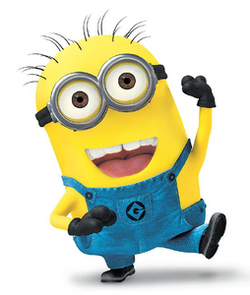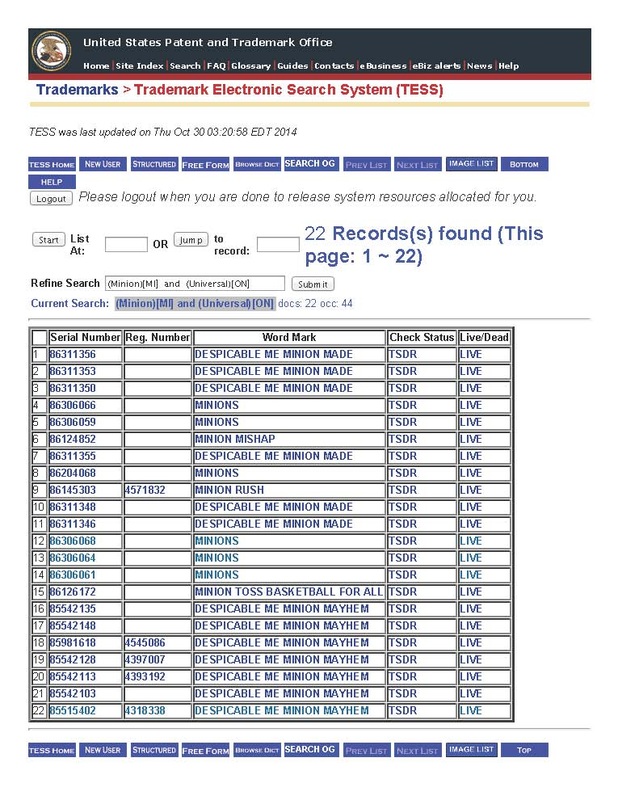
But seriously, everybody is familiar with the protagonist of a movie. He has the most time on screen, usually brings about some positive outcome, and is generally one cool operator. One might expect such a character to have a lot of appeal off-screen and to drive merchandising purchases by consumers. Secondary characters may not be as popular simply for the reason that they aren’t as well-recognized by the viewing audience and do not play any significant role in the film, which is why it is surprising when secondary characters do acquire success off-screen.
Take Minions from Despicable Me, for example. Yes Minions, those funny yellow beings that follow Gru around and seem to hang on his every word (after all, isn’t that what a loyalist does best?) are the subject of a new movie to be released next year. Titled “Minions”, the film chronicles the quest of the little henchmen to find their next employer. But that’s not the only place where Minions are popping up. Giant balloons, building blocks, talking plastic toys, even cell phone cases, all bare the likeness of the minion.
For the Despicable Me franchise, Minions have burst onto the scene as a hugely popular secondary character. When they made their appearance in the first installment, the director did not think they would become such a key element of the film. Now, 5 years later, Minions are not only a key element of the films, they form a piece of a multi-million dollar franchise that has traversed from the screen straight into mainstream culture.
The minions fall into the category of characters that move from the screen as animations and simple elements of a storyline to a cult-like symbol. Consumers look at these figures as cute, comical, and filled with infectious traits such as a gibberish language that is only slightly intelligible. This success appears to be accidental and organic, purely a bi-product of the audience’s response to the character. There are some examples of these types of characters across different movies (Oompa Loompas from Willie Wonka and the Chocolate Factory, Jawas from Star Wars, and the small green squeak toy aliens from Toy Story), but none seem to have achieved quite the success that the minions have.
And Universal is reaping all of the benefits. From follow-on productions in the form of prequels and sequels to licensing deals with toy makers, minions are seemingly covering the world like a massive blob of yellow. Besides direct revenue from sales of merchandise bearing the minion image, how is Universal benefitting from the name? By now, of course, minions are intricately linked with the movie Despicable Me and every appearance of minion anything seems to implicate the movie. Much as Mickey Mouse has become synonymous with Disney, it seems like the minion is becoming synonymous with Universal. The minion appears to be fulfilling the role of a trademark: with a distinctive set of features and a name that may not be so obvious on the surface, and with a clear connection to a product (motion picture, in this case) that is put out by a studio, consumers can draw the connection to Universal. That connection, of course, has tremendous value for a trademark owner.
Universal is capitalizing on the value of this connection by filing numerous trademark applications for marks that include MINIONS:
When parsing a thing to determine what kinds of legal protections are available, you have to get out a relatively fine-toothed comb with an eye to the contours of those legal protections. In this case, the design of the characters themselves is protected by a copyright. The shape, colors, movement, basically everything inside of the movie itself is copyright protected. The idea of the character (i.e. a babbling creature that gets into mischief and follows a leader around) is not protected because, lets face it, that’s a plot line and character profile we’ve all seen before. The expression of those traits and plot elements in the form that Universal has created in the Despicable Me franchise is protected as a copyrighted element.
Copyright protection doesn’t protect the fact that the minion character is indicative of Universal as the developer of that character, or the word MINION. Nor can a copyright be used in the marketplace in the same way that a word or symbol could be used. After all, the goal of copyright is to protect original and creative expression from being copied by somebody else; trademark law is more concerned about protecting the affiliation of some symbol with its owner.
Recognizing that it wanted to protect the value of the MINION name and ensure that it always tied back to the Universal, the need to get a trademark on the MINION name was fulfilled. Having a trademark will allow Universal to freely license the MINIONS name to companies that make products without requiring Universal to make the products themselves. Because Universal owns the trademark, people will recognize MINIONS as an identity of Universal and its film, Despicable Me. This will contribute additional revenue to Universal and continue to bring recognition to the film, beyond the screen.
You may be wondering about the drawings of the minions themselves and their likeness. If the name MINIONS is linked to a character of a Universal film, shouldn’t the characters themselves, which are uniquely designed and almost certainly recognizable as a symbol of Despicable Me, be trademarked?
Perhaps. The hang-up here is that the character shape itself is hard to define, at least in the sense that it could function as a logo or a symbol. Unlike Shrek or Buzz Lightyear, the minions do not have a single form. True, there are common characteristics across all minions in the film (yellow skin, wild hair, glasses, and blue overalls) but these features may not be easily boiled down into one single character profile. Universal might find, some time in the future, that one particular minion character is representative of all and seek a trademark on the shape of that one character, much like Disney has obtained a trademark for the silhouette of Mickey Mouse’s head and ears.
I am a big fan of the minion character, probably for the same reasons that everyone else is. With Universal’s latest bid to obtain trademarks on the MINION name, we may be in the midst of a minion movement. It’s just Universal trying to maximize their I.P. for all its worth. So in this sense, when Universal sees its minions, it probably sees more GREEN than YELLOW, if you catch my drift.



 RSS Feed
RSS Feed